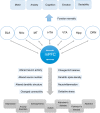Medial prefrontal cortex in neurological diseases
- PMID: 31373533
- PMCID: PMC6766703
- DOI: 10.1152/physiolgenomics.00006.2019
Medial prefrontal cortex in neurological diseases
Abstract
The medial prefrontal cortex (mPFC) is a crucial cortical region that integrates information from numerous cortical and subcortical areas and converges updated information to output structures. It plays essential roles in the cognitive process, regulation of emotion, motivation, and sociability. Dysfunction of the mPFC has been found in various neurological and psychiatric disorders, such as depression, anxiety disorders, schizophrenia, autism spectrum disorders, Alzheimer's disease, Parkinson's disease, and addiction. In the present review, we summarize the preclinical and clinical studies to illustrate the role of the mPFC in these neurological diseases.
Keywords: cortical region; medial prefrontal cortex; neural circuit; neurological disease; pathophysiology.
Conflict of interest statement
No conflicts of interest, financial or otherwise, are declared by the authors.
Figures


References
Publication types
MeSH terms
Grants and funding
LinkOut - more resources
Full Text Sources
Medical

